Truck And Bus Radial (TBR) Tire Market Size and Trends
Truck & bus radial (TBR) tire market is estimated to be valued at USD 19.27 Bn in 2025, and is expected to reach USD 31.58 Bn by 2032, growing at a compound annual growth rate (CAGR) of 7.3% from 2025 to 2032.
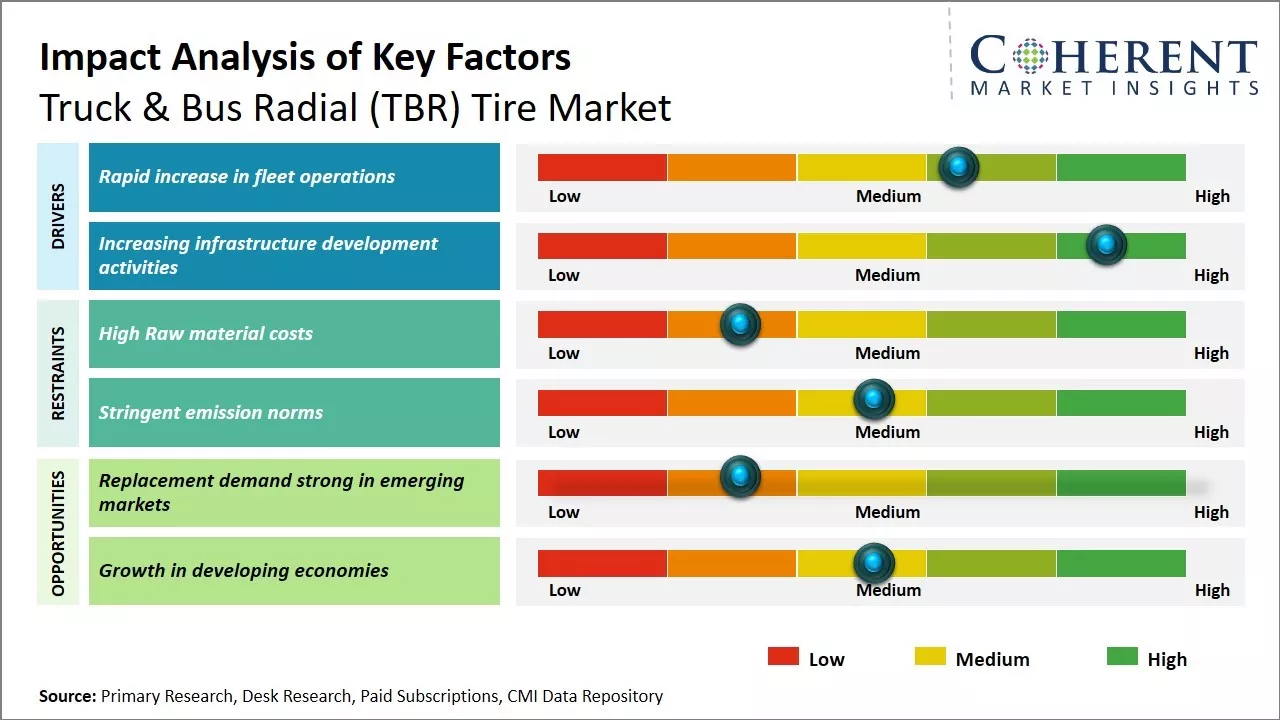
Discover market dynamics shaping the industry: Download Free Sample
The demand for TBR tires is expected to grow due to rising transportation and logistics industries across the globe. With growth in e-commerce and increasing transportation of goods, the demand for commercial vehicles such as trucks and buses is growing. This is expected to drive the need for replacement of tires and also demand for new vehicles which will require TBR tires. Moreover, support from governments across countries on infrastructure development is also helping to drive commercial vehicle traffic. New regulations regarding fuel-efficiency and safety are further expected to boost replacement demand for advanced TBR tires. However, rising raw material costs may pose a challenge to market players in the future. Steady growth in commercial vehicle production and fleet is anticipated to drive the market growth during the forecast period.
Rapid increase in fleet operations
The truck & bus industry has witnessed significant growth over the past decade with more companies relying on fleet operations to efficiently transport goods and people. There has been a rise in e-commerce and just-in-time delivery models adopted by numerous industries which has vastly increased demand for commercial vehicles. Fleet owners are procuring newer vehicles that can log higher mileages while keeping maintenance costs low. This has naturally driven the need for high quality tires that offer enhanced durability and fuel efficiency. TBR tires are specially designed to handle the heavy loadings of commercial vehicles and withstand frequent starts and stops during city or short-haul operations. Their deep tread patterns and extra layer of rubber also provides better traction and reduces the risk of accidents on busy roads. Most fleet owners prefer reputed TBR brands as it allows for higher vehicle uptime and lower total cost of ownership over the lifespan of trucks and buses. Over the next five years, more companies expanding their logistics networks or passenger transportation services will continue adding new vehicles to their existing fleets. This widespread fleet modernization process across industries represents a key growth opportunity for TBR tire manufacturers.
Market Concentration and Competitive Landscape
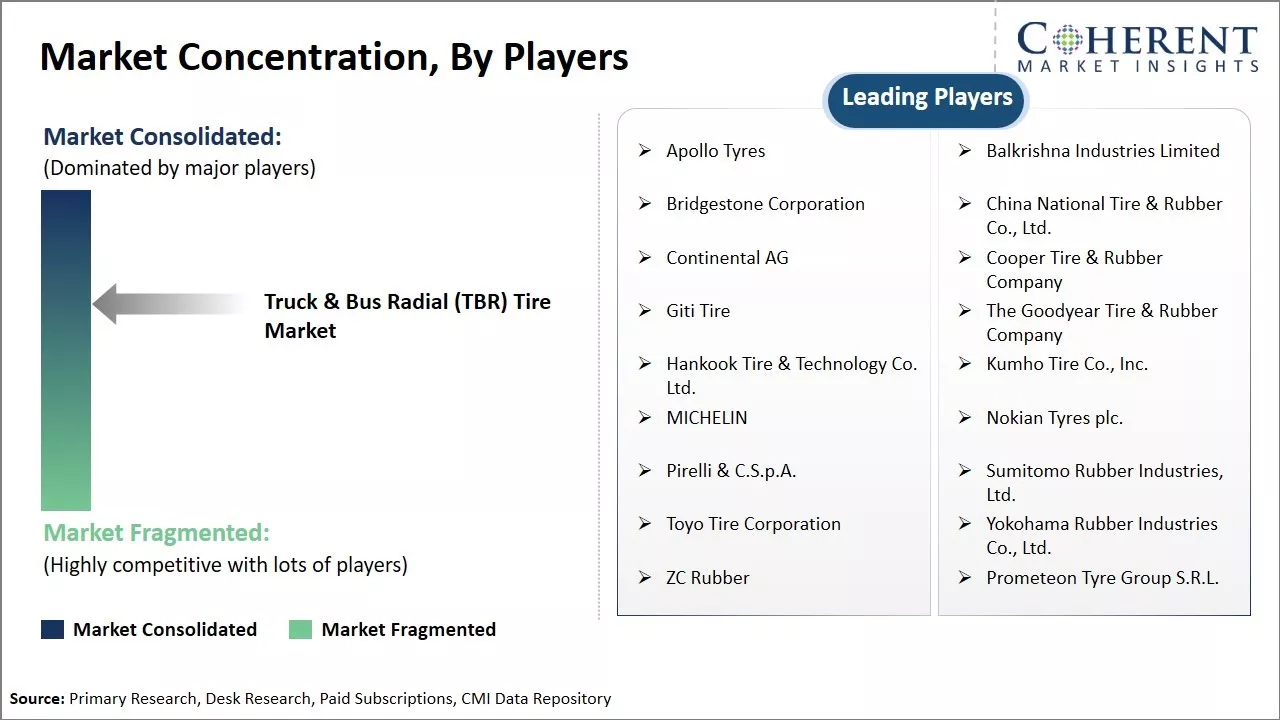
Get actionable strategies to beat competition: Download Free Sample
Increasing infrastructure development activitiesAcross major developing economies, the focus on improving transportation and logistics infrastructure has intensified over the past decade. Several countries have announced ambitious plans to expand road networks, highways, ports and develop smart cities with metro rail projects. This infrastructure push involves a considerable amount of construction activity utilizing equipment such as loaders, excavators, cranes and dump trucks. It also needs a steady supply of construction raw materials to be transported on site. All this leads to higher demand for commercial vehicles as more projects are commissioned. The off-highway tires fitted in such vehicles covering mine sites, construction zones and ports require durable TBR tires that can offer grip even in muddy conditions. Increase in infrastructure spending has boosted regional and inter-city passenger and freight transportation needs. More highways incentivizes greater truck and bus traffic volumes over time. The modernization of roads and rail networks to facilitate just-in-time logistics requires reliable TBR tires on commercial fleets. As infrastructure expenditure remains a priority in developing nations, the construction sector and transportation demands will continue spurring replacement sales of TBR tires for on-highway and off-highway applications.
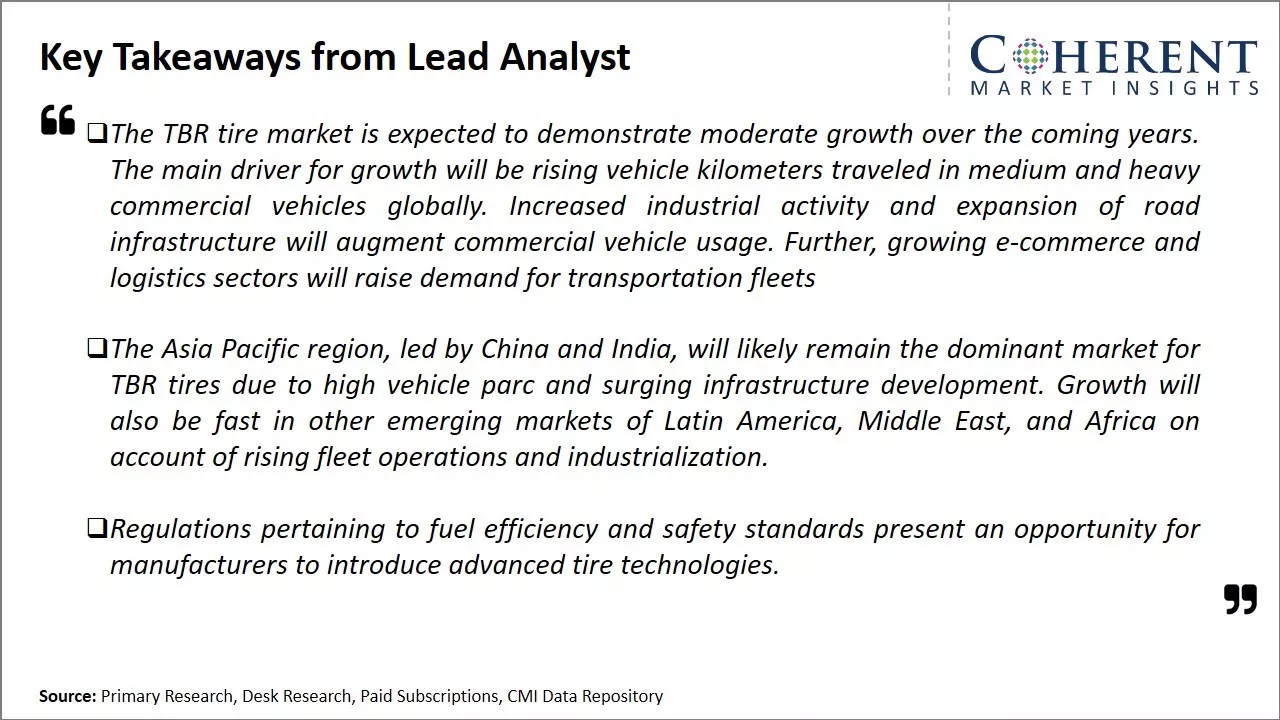
To learn more about this report, Download Free Sample
Market Challenges: High Raw material costsThe truck & bus radial (TBR) tire market faces several challenges. Raw material costs have risen significantly over the past year, squeezing manufacturer margins. Furthermore, economic uncertainty has led to decreased fleet purchases of new commercial vehicles. This has slowed the replacement cycle for tires. Stricter emission regulations requiring lower rolling resistance are increasing R&D costs. Market saturation in key regions like North America and Europe leaves little room for volume growth.
Market Opportunities: Replacement demand strong in emerging markets
Replacement demand remains strong in emerging markets as the commercial vehicle parc expands. Many markets such as India and Brazil are in the early to middle stages of the replacement cycle, promising future growth. Manufacturers can gain share by developing tires that offer improved fuel efficiency and safety to help customers lower operating costs. There is also scope to increase market penetration in off-highway.
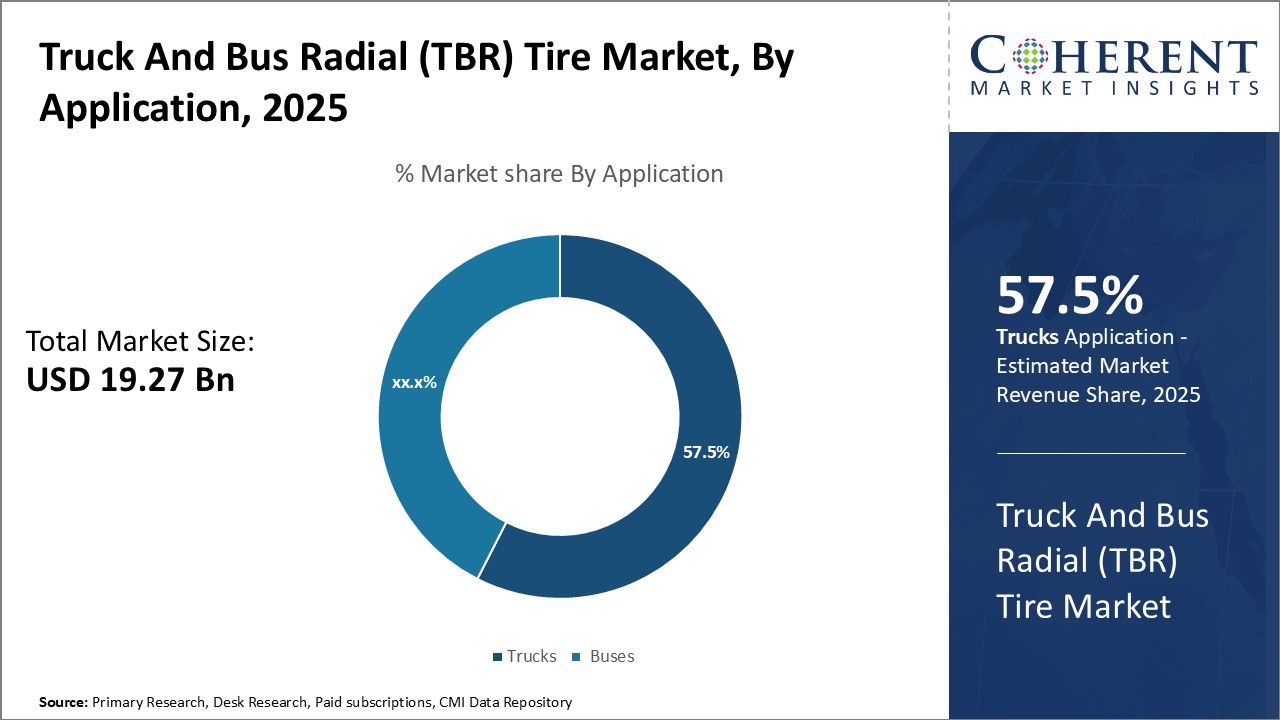
Discover high revenue pocket segments and roadmap to it: Download Free Sample
Insights, by application: increased road freight transportTrucks segment contributes the 57.5% market share. The trucking industry has witnessed significant growth over the past few years due to expanding road freight transport activities. Trucks are indispensable for the smooth functioning of supply chain networks as these allow for flexible and on-demand transportation of a variety of goods over long and short distances. Rising e-commerce activities has further boosted demand for truck transportation to deliver products to customers. Key factors propelling the truck segment include growth of industries such as construction, manufacturing, mining and energy which generate high volumes of freight traffic. Trucks offer a cost-effective solution for transportation of bulk commodities. Moreover, ongoing infrastructure projects related to roads, highways and bridges have increased demand for construction materials and equipment, benefitting the trucking sector.
Insights, By Sales Channel: Aftermarket contributes the 45.75% due to advantages over OEM fittings Aftermarket contributes the highest share due to advantages over OEM fittings. The aftermarket segment dominates TBR tire replacements owing to certain advantages over tires fitted by OEMs during vehicle production. Aftermarket players offer a diverse range of tire brands and models at competitive prices as compared to limited OEM options. Customers prefer replacing older tires through aftermarket channels for features like extra tread depth suitable for varying road conditions and loads. Many fitment options are available for truck models across all age groups. This flexibility drives repeat purchases from established retail chains and independent fitters. Unlike OEMs who bundle tire prices along with the vehicle, aftermarket retailers provide transparency in costs. Customers can choose specific tires based on unique technical specifications and pricing. Furthermore, aftermarket players provide value-added services like wheel alignment, balancing and fitting which attract commercial fleet owners.
Regional Insights
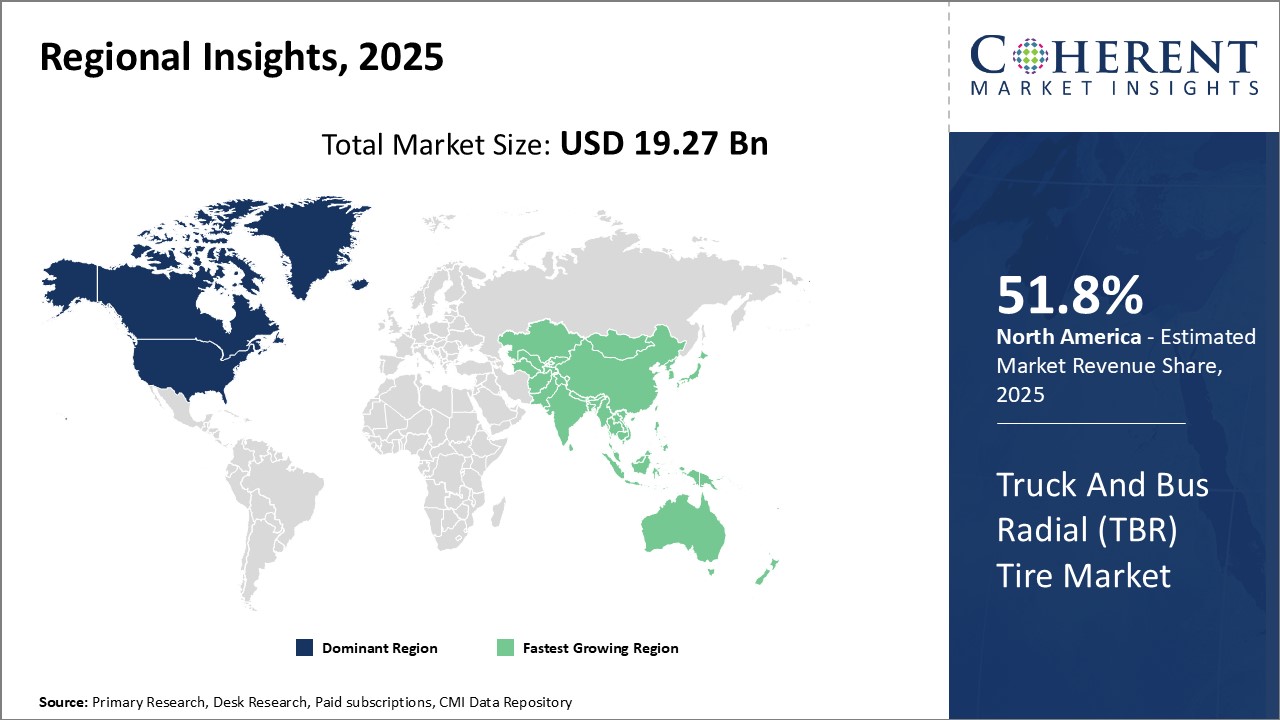
Need a Different Region or Segment? Download Free Sample
North America has established itself as the dominating region with 51.8% share in the market over the years. The region is home to some of the largest commercial vehicle fleets as well as tire manufacturers in the world. Countries such as the U.S. and Canada have robust commercial transportation and logistics infrastructure which generates steady demand for TBR tires. Most global tire companies have established a strong manufacturing and distribution footprint in the region to cater to the massive market. The presence of leading OEMs along with an extensive aftermarket ensures a continuous demand for replacement tires as well. Furthermore, stringent vehicle emission and fuel efficiency regulations have propelled adoption of advanced radial tires.
The Asia Pacific region has been witnessing exponential growth in the TBR tire market and is emerging as the new hotspot. Rapid economic development and industrialization across developing nations like China and India has boosted infrastructure and commercial vehicle parc. This has translated into higher consumption of TBR tires for applications such as trucks, buses, mining and construction. Local and global tire companies are aggressively expanding capacity in the region to leverage the lucrative opportunities. The preference for Chinese tires is increasing in domestic as well as export markets due to competitive pricing and quality improvement. Most global players now source China as a key base to supply Asia and other developing markets. The rising intra-regional trade and growing transportation networks in Southeast Asia are further stimulating demand.
Market Report Scope
Truck And Bus Radial (TBR) Tire Market Report Coverage
| Report Coverage | Details | ||
|---|---|---|---|
| Base Year: | 2024 | Market Size in 2025: | USD 19.27 Bn |
| Historical Data for: | 2020 To 2024 | Forecast Period: | 2025 To 2032 |
| Forecast Period 2025 to 2032 CAGR: | 7.3% | 2032 Value Projection: | USD 31.58 Bn |
| Geographies covered: |
|
||
| Segments covered: |
|
||
| Companies covered: |
Apollo Tyres, Balkrishna Industries Limited, Bridgestone Corporation, China National Tire & Rubber Co., Ltd., Continental AG, Cooper Tire & Rubber Company, Giti Tire, The Goodyear Tire & Rubber Company, Hankook Tire & Technology Co. Ltd., Kumho Tire Co., Inc., MICHELIN, Nokian Tyres plc., Pirelli & C.S.p.A., Sumitomo Rubber Industries, Ltd., Toyo Tire Corporation, Yokohama Rubber Industries Co., Ltd., ZC Rubber, Prometeon Tyre Group S.R.L. |
||
| Growth Drivers: |
|
||
| Restraints & Challenges: |
|
||
Uncover macros and micros vetted on 75+ parameters: Get instant access to report
Truck And Bus Radial (TBR) Tire Industry News
- In 2022, Apollo Tyres launched five new truck-bus radial tires for the Indian market, consisting of steer, drive, and all-wheel fitment tires. The new products have been extensively tested in real-world applications across the country before being introduced. The tires are designed to enhance customers' operational productivity and offer the best in technology.
- In 2022, Hankook launched its first truck and bus radial tire in the iON range, called the Smart iON AU06+. The tire is designed for premium electric vehicles in the Korean market and incorporates Hankook's EV tire technology for improved fuel efficiency, fast torque response, and high load support
- In July 2020, Continental AG launched a new truck tire. The new Conti Scandinavia HS3 ED steer-axle tire was created specifically for goods transportation in wintry mixed on/off-road condition.
- In December 2021, Bridgestone Corporation announced the consolidation of its TBR tire manufacturing operations in China to increase growth opportunities. The goal of this project, which is a part of the Mid Term Business Plan (2021-2023), is to rebuild earning power to enhance strategic growth investment.
*Definition: Truck & Bus Radial (TBR) Tire Market involves the production and sales of radial tires that are designed specifically for use on trucks and buses. TBR tires differ from standard passenger vehicle tires as these are built to withstand higher loads and endure longer distances. These feature a reinforced tread and sidewall for enhanced durability to handle heavy payloads and frequent use over long hauls.
Market Segmentation
- Application Insights (Revenue, USD Bn & KT, 2020 - 2032)
- Trucks
- Buses
- Sales Channel Insights (Revenue, USD Bn & KT, 2020 - 2032)
- Aftermarket
- OEMs
- Regional Insights (Revenue, USD Bn & KT, 2020 - 2032)
- North America
- U.S.
- Canada
- Latin America
- Brazil
- Argentina
- Mexico
- Rest of Latin America
- Europe
- Germany
- U.K.
- Spain
- France
- Italy
- Russia
- Rest of Europe
- Asia Pacific
- China
- India
- Japan
- Australia
- South Korea
- ASEAN
- Rest of Asia Pacific
- Middle East
- GCC Countries
- Israel
- Rest of Middle East & Africa
- North America
- Key Players Insights
- Apollo Tyres
- Balkrishna Industries Limited
- Bridgestone Corporation
- China National Tire & Rubber Co., Ltd.
- Continental AG
- Cooper Tire & Rubber Company
- Giti Tire
- The Goodyear Tire & Rubber Company
- Hankook Tire & Technology Co. Ltd.
- Kumho Tire Co., Inc.
- MICHELIN
- Nokian Tyres plc.
- Pirelli & C.S.p.A.
- Sumitomo Rubber Industries, Ltd.
- Toyo Tire Corporation
- Yokohama Rubber Industries Co., Ltd.
- ZC Rubber
- Prometeon Tyre Group S.R.L.
Share
Share
About Author
Ameya Thakkar is a seasoned management consultant with 9+ years of experience optimizing operations and driving growth for companies in the automotive and transportation sector. As a senior consultant at CMI, Ameya has led strategic initiatives that have delivered over $50M in cost savings and revenue gains for clients. Ameya specializes in supply chain optimization, process re-engineering, and identification of deep revenue pockets. He has deep expertise in the automotive industry, having worked with major OEMs and suppliers on complex challenges such as supplier analysis, demand analysis, competitive analysis, and Industry 4.0 implementation.
Missing comfort of reading report in your local language? Find your preferred language :
Transform your Strategy with Exclusive Trending Reports :
Frequently Asked Questions
EXISTING CLIENTELE
Joining thousands of companies around the world committed to making the Excellent Business Solutions.
View All Our Clients
